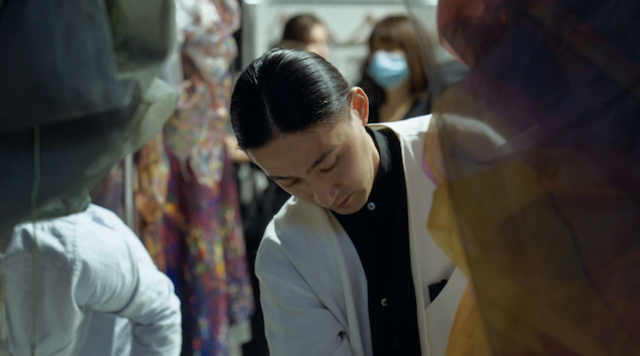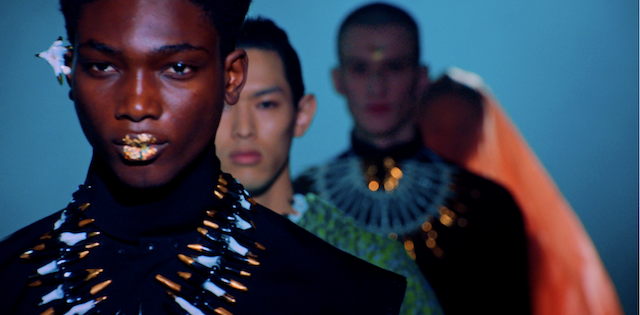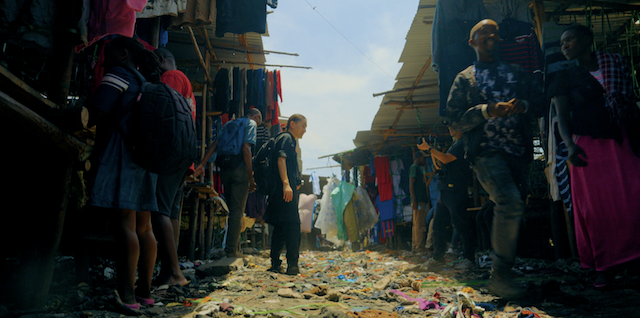
©Courtesy of Tribeca Festival
While the environmental and ethical damages caused by the fashion industry have garnered significant attention in recent years, fashion remains an enduring aspect of human culture, and people’s desire to shop for clothes continues unabated. If eradicating the source of harm is impossible, we must seek a middle ground where fashion respects both consumers and the environment.
Yuima Nakazato, a prominent Japanese fashion designer, is one of the leading figures in the ethical manufacturing movement. Known as the only second Japanese designer to be invited to Paris Haute Couture Fashion Week after Hanae Mori, Nakazato is committed to blending his distinctive artistic vision with green technology. The designer’s journey towards socially responsible fashion, spanning from Kenya to Paris, is documented in Kosai Sekine’s debut film, Dust to Dust.
The film won the 2024 Human/Nature Award at this year’s Tribeca, highlighting Sekine’s caliber in interweaving a solution-oriented environmental vision with his striking visual storytelling. From TV commercials to narrative features, Sekine has established his prominence as a multidisciplinary filmmaker, with his past works being recognized at multiple international film festivals, including the Kinotayo Film Festival and the Cannes Lions International Festival of Creativity. Alongside his filmmaking, Sekine has been involved in social art activism, demonstrating a keen awareness of socio-political conversations in Japan.
Exclusive Interview with director Kosai Sekine
Q : Designer Yuima Nakazato: How did you first meet him, and what about his design, craft, or personality made you want to make this film?
Kosai Sekine : Yuima and I first met about four years ago for a different project. I had known him as a prominent designer with a strong focus on social issues. When I saw his past collections, what mesmerized me most was his commitment to not only raising social issues but also advocating for solutions through his work. As an artist, it’s common to pose questions through your creations, but not everyone can advance their arguments beyond merely asking those questions.
Yuima, however, doesn’t stop there; he proposes possible solutions to the issues he highlights. An example of this is Spider’s silk protein featured in the film. Yuima also took an interest in me because of my advocacy on a wide range of social issues, both inside and outside of filmmaking, including the problems of nuclear power plants and immigration policies. This shared sense of purpose led us to collaborate on this project.
Q : In the first half of the film, you and Ms. Nakazato went to Kenya to see the scale of textile waste. What prompted this trip?
Kosai Sekine : Yuima had been expressing a desire to see the end of the clothing life cycle. Many “conscious” films about the environmental and ethical issues in the fashion industry focus on the beginning of the fashion manufacturing cycle, highlighting extremely poor working conditions, such as in Andrew Morgan’s The True Cost. While these films successfully raise awareness about how clothes are made, Yuima and I wanted to explore the other end of this cycle.
One day, Yuima brought a Reuters report to my attention about a mountain of discarded clothes in Chile’s desert and suggested we shoot a film there. Although we ultimately couldn’t film in Chile for several reasons, our research revealed that enormous amounts of secondhand clothes are imported and dumped in countries of the Global South. Particularly in African nations, there is a long history of importing secondhand clothing, with Kenya being the largest market for it in East Africa. On the spur of the moment, we planned a shooting trip to Kenya, and the project quickly took shape.
Q : The almost impulsive trip to Kenya to see the cycle came on the heel, but the massive landfill made of abandoned clothes sent from the rest of the world — was it still beyond what you and Ms. Nakazato ever expected?
Kosai Sekine : Absolutely. Before our visit, Yuima and I expected to see a “tragedy,” much like the media often frames this kind of socio-environmental issue: an overwhelming volume of used clothes from the Global North ending up in landfills, creating devastating consequences for the environment and communities.
However, upon arrival and engaging with the locals, we encountered a much more complex reality. The massive dumpsite provided a livelihood for some people; they were raising their children and making a living by picking up pieces of clothing from there. It was a perplexing and wild sight, with small children scavenging scraps for money amidst suffocatingly large piles of clothes.
In Kenya, secondhand clothes imported from the West used to be a valuable commodity, fueling the nation’s secondhand clothing market. However, the growth of this market has harmed the country’s traditional textile production and exacerbated climate change, leading to severe droughts.
Another shocking revelation was that the clothes abandoned there were truly the bottom of the barrel; they were duplicates of Western fast fashion brands like Forever 21 and H&M, made at an even lower cost in countries like China and Turkey. The landfill in the film, located right next to the slum, was filled with these extremely poorly made clothes that were never picked as reusable textiles. Sometimes, they spontaneously caught fire, creating a strange and disturbing scene.

©Courtesy of Tribeca Festival
Q : Later in the trip, you two visited a tribal village where people still wear traditional clothes and jewelry. This scene feels like a stark contrast to the earlier part of the film, where the gruesome reality of the fashion industry — marked by overconsumption and cheap manufacturing — had deteriorated the fashion landscape of the nation.
Kosai Sekine : It was certainly a groundbreaking experience, revealing that fashion is a double-edged sword, which urged Yuima to ask himself an existential question as a designer. At the dumpsite, fashion had lost its purpose; too many garments were poorly produced and barely consumed, now sitting in a grave causing plights for people. In the northern desert of Kenya, where inter-tribal violence erupts over land and livestock ownership, fashion serves as the pillar of tribal identities.
Despite the volatile and dangerous environment, the villagers dressed lavishly in vibrant dresses and beaded jewelry. Young warriors adorned themselves with beautiful, decorative pieces before going into battle, challenging my understanding of fashion. I had never regarded fashion as imperative to human existence.
However, seeing how traditional, elaborate fashion was so firmly ingrained in their lifestyle and identity, even under harsh conditions, revealed to us the significant role fashion can play in the dignity of civilization. Neither Yuima nor I had expected this sort of enlightening moment to ponder on “the meaning of fashion,” in this sense, and I’m sure it gave Yuima lots of think about.
Q : The second half of the film features an unexpectedly dramatic arc as Ms. Nakazato was reeled from so many ups and downs. Since this second chapter is set in a completely different place and has a distinguishable tone as well as subjects, was there anything you were mindful or particular about during that transition?
So much drama arose one after another once we returned to Tokyo and Yuima began preparing for the runway. So much happened that it might seem staged to some poeple, but it wasn’t. With a limited budget and a small team, it was logistically very ambitious for Yuima to tap into the ethical manufacturing technology for his runway collection in such short period. As shown in the film, there were several moments where I, let alone Yuima himself, wasn’t sure if he could manage it.
I am very grateful to him for allowing me to film by his side the entire time, even in troubling situations, and document the behind-the-scenes of the arduous production process through his perspective. My intention in making this film wasn’t to preach or create a “textbook” dictating what’s right and wrong.
Throughout this production, I was dedicated to documenting what unfolded in front of Yuima’s eyes, which allowed the focus to remain purely on his earnest passion for tackling these issues through his creations. I wanted the film to provide audiences with first-hand insight into this matter through his point of view and prompt them to ponder their own solutions; his approach featured in the film is one answer, but not the only one.
Q : Your professional background encompasses a wide range of expertise, which I’m sure has given you a holistic artistic vision. From commercial shoots to music videos to short films and documentaries, is there a specific area where you feel your strengths are particularly pronounced?
Kosai Sekine : During my collage exchange program in the U.S., I studied photography and became very fond of shooting with a film camera. After returning to Tokyo, I started working in advertising film productions to get the opportunity to work with 35 mm film cameras. As I gained a foundation in filmmaking through my commercial gigs, I began watching foreign advertisements as a learning resource.
I discovered that many well-known filmmakers began their careers making TV commercials, using them to explore artistic possibilities and hone their videography skills. In fact, the commercials they created were often quite amusing. Naturally, it inspired me to take on that career path and as I went on, I became more devoted to this world of commercial videography.
As time progressed and society evolved, our reception of commercials changed too. In the world of overflowing visual content that we now live in, we encounter an overwhelming amount of video on a daily basis—from reels to ad videos. This abundance means that each individual video no longer carries as much weight or meaning in its communicative purpose. Nowadays, we even pay to skip ads on platforms like YouTube.
It’s a phenomenon similar to what is happening in the fashion industry, where an excessive amount of content is produced at an incredibly low cost, diluting its value. This realization made me want to focus more on filmmaking, which I believe allows me to be more intentional about delivering deeper, meaningful messages.

©Courtesy of Tribeca Festival
If you like the article, share tour thoughts below!

